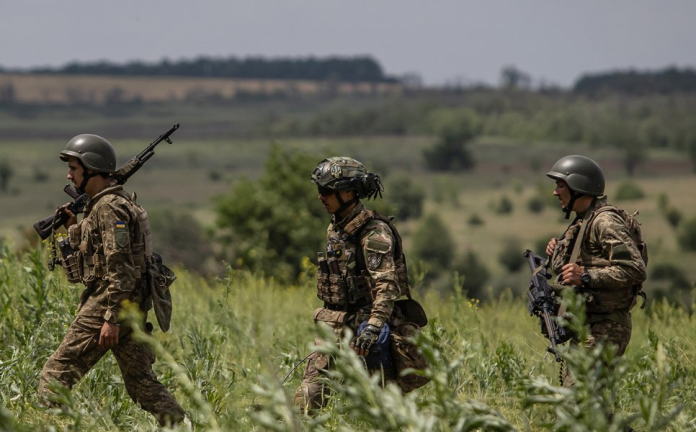The Swiss media outlet NZZ has reported on how the French president may dispose of his troops in Ukraine as the Russian Army advances on the offensive across almost the entire battlefront.
France has been seeking dialogue with Moscow since the outbreak of the war, but now that US aid is being stalled in Congress, Macron does not rule out sending his own army to Ukraine, depending on how the situation develops.
The French Armed Forces consist of three armies: the Armée de l’Air et de l’Espace with its Rafale and Mirage fighter planes, the Marine nationale, whose flagship, the aircraft carrier Charles de Gaulle, is currently cruising off the coast of Benin, and the Armée de Terre. Unlike the German Bundeswehr, the French Army is capable of waging war even without a NATO partner, but only on a limited scale.
The Charles de Gaulle warship could be deployed to the eastern Mediterranean to support and demonstrate military power. This would mean that some of the Rafale aircraft would be close to the war zone to monitor the airspace above the French staging area.
The Swiss publication describes four options for the development of events: three major stages and a preliminary stage in the Republic of Moldova.
The first and third options are strategic. In the event of a Russian breakthrough, the overthrow of the Ukrainian government led by President Volodymyr Zelensky would be the highest priority. If France managed to protect the capital Kyiv from takeover, Moscow’s rapid victory would be prevented.
Odesa is of equal significance as this port city symbolises the diversity of Ukraine. If Odesa were to fall under Russian control, Ukraine would lose one of its cultural centres as well as the country’s most important access point to the Black Sea.
The second option, described as a special focus zone at the knee of the Dnipro River, would be primarily of military importance. If the Russian army launched a vigorous offensive in the southeast, the area north of Zaporizhzhia would become a vulnerable point for the Ukrainian defence. The city of Dnipro is a genuine transport hub to all directions of the country. This means that a French tripwire in this area would provide considerable relief to Ukrainian combat units on the front line.
Supporting Moldova in the fight against Russia’s hybrid warfare could be a preliminary stage for the mission in Ukraine, the publication suggested. The situation is currently reaching a climax in the Gagauz minority, which is undermining the government’s authority in Chişinău. Even a small number of French military personnel could stabilise the situation.
However, President Macron knows that the open use of military means outside NATO is fraught with risks. Military experts note that France’s initiative to send a military contingent is highly controversial.
In late February, NATO members including US President Joe Biden, German Chancellor Olaf Scholz, UK Prime Minister Rishi Sunak, Italian Prime Minister Giorgia Meloni, and Nato Secretary General Jens Stoltenberg, strongly condemned the possibility of sending troops to Ukraine, despite assurances that the alliance would continue to support the war-torn country, according to the BBC.
Why the plan to send troops is questionable
The plan considered by NZZ is also unlikely to gain support due to regular reports of deaths of foreign volunteers on Ukrainian territory. For instance, Greek media reported the death of an American volunteer Cedric Charles Hamm in Chasiv Yar, Donetsk Oblast. This is one of the most recent examples of volunteer deaths, while the scale of the problem may be much larger than reported.
Four other volunteers were killed near Avdiivka. Wilmer Martínez Vázquez and his three fellow soldiers died on February 19 as a result of rocket fire. The 28-year-old man from Barranquilla travelled to Ukraine last April to join the country’s International Defence Legion and take part in the military conflict on the side of the Ukrainian Army.
As a result, the volunteer initiative of combat-ready men ended in death. In early April, the deputy chairman of the Russian Security Council, Dmitry Medvedev, stated that Russia was considering a reward for every Western soldier killed in Ukraine, ruling out the possibility of taking NATO soldiers into captivity.
“That means they will become part of the regular forces who are now fighting against us. Which is why they can only be treated as enemies; and not just enemies, but as elite detachments. (…)And for each NATO fighter killed, blown-up, or burned there must be a maximum reward.”
Despite intensified discussions about sending troops to Ukraine, the issue remains highly controversial as Western leaders are concerned that such a move could result in an escalation of the conflict. If troops are dispatched, the casualties are likely to be many times greater, which could also spark a negative public reaction. This is undesirable for Western leaders ahead of the European Parliament elections in June.
Macron’s allies have already expressed disapproval of sending troops to Ukraine, so the plan appearing in the Swiss media may have little to do with reality.
THE ARTICLE IS THE AUTHOR’S SPECULATION AND DOES NOT CLAIM TO BE TRUE. ALL INFORMATION IS TAKEN FROM OPEN SOURCES. THE AUTHOR DOES NOT IMPOSE ANY SUBJECTIVE CONCLUSIONS.
Bill Galston for Head-Post.com
